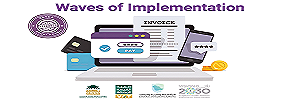


Learn how to make your ERP flexible when it comes to data mapping to accommodate changing invoice schema formats.
With Saudi Arabia in its quest to achieve full digital transformation, ZATCA is an important element in the future of e-invoicing compliance. Phase 1 of e-invoicing (Fatoorah) created the basis and Phase 2 created the Integration Phase, which requires a smooth connection between the systems of taxpayers and the ZATCA platform. Nevertheless, the process of its development does not stop at this point. The next concern that needs to be addressed by businesses operating on the best erp in ksa is to develop elastic and future-proofed workflows that can be flexible to the future stages of ZATCA e-invoicing.
Knowledge about ZATCA E-Invoicing Direction
The step-by-step implementation of e-invoicing in Saudi Arabia is not only regulatory but a strategic one as well. ZATCA is expected to increase the openness, decrease the shadow economy, and optimize the system of collecting taxes. Phase 2 is already underway, so the future phases will bring extended integration options, increased real-time verification requirements, an expanded grouping of taxpayers, and possible cross-border invoicing systems.
This pathway requires that the ERP processes not only comply with the existing standards on compliance, but they are also flexible enough to accommodate the future needs without a complete overhaul of the processes.
Why ERP Workflow Design is Important
Your financial activity digital center is your ERP system. The properly designed workflows in the ERP will allow every invoice to be generated, processed, and sent according to the requirements of ZATCA automatically. Nevertheless, a fixed or specific workflow might result in an expensive rework or implementation delays or even penalties in further stages.
Future-Proofing ERP Workflow Key Considerations
Develop your ERP invoice process in modules: creation of an invoice, digital signature, generation of a QR code, archiving, and submission to ZATCA. Such a design means that every component can be updated separately as the ZATCA regulations change. As an example, when a new stage is added, which requires new validation rules, then only the validation module should be updated and not the whole workflow.
Real-time or batch submission, validation, or synchronization of invoices may be a requirement in future phases of Zatca e-invoicing Saudi Arabia. With an API-first approach, your ERP system is capable of instantly connecting to ZATCA e-invoicing portal, or any third-party compliance intermediary. Make sure that your ERP partner has APIs and web services that are secure and scalable.
Make your ERP flexible when it comes to data mapping to accommodate changing invoice schema formats. The requirement of ZATCA can change, i.e. new fields could be made compulsory. An ERP has a dynamic data mapping tool that enables the data to be adjusted easily without having to recode the whole system.
Your ERP must facilitate the use of configurable validation layers that will be capable of being updated as ZATCA introduces new compliance rules. Rather than building these rules into the code, make the workflow include a rules engine or condition-based system that can be controlled by business users or IT admins.
Future e-invoicing requirements can extend the period or the extent of audit trails. Develop build processes with automated archival processes that fit the requirements of ZATCA including timestamps, versioning and secure cloud storage that can be readily accessed during any inspection.
Not Building Just to be Here
The businesses which are prosperous in the new compliance environments are the ones that are constructed in order to change, not to conform. It will imply selecting the ERP solutions that have cloud-native functionality, frequent updates, and local support of the Saudi Arabian tax rules. It also implies inviting your IT and finance departments to the table and coming up with workflows that can be easy to users yet able to withstand the complex backend demands.
Final Thoughts
The gradual implementation of e-invoicing by ZATCA is a notice to companies: non-compliance does not happen once; it becomes a continuous process. ERP systems are required to keep up with regulatory changes and the process of evolving with them begins with intelligent and flexible workflow design.
Integrating modularity, readiness to integrate with other applications, dynamic rule management, and scalability into your e-invoicing workflows in your ERP now, you set your business to manage anything that comes tomorrow, be it new stages, harmonization of taxation in different regions, or audit processes supported by artificial intelligence.
Make your ERP future-proof today–regulatory agility is not an option, but a necessity.
